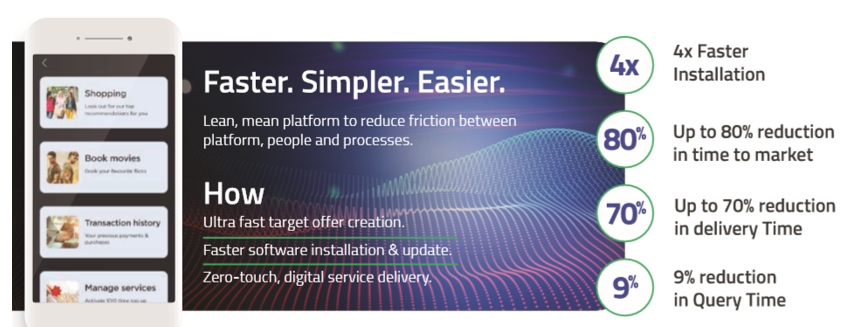We discuss the following topics in this blog:
- Why is Digitisation Important?
- How can Platformication Help?
- dTelco – Digital transformation with STL’s flagship solution
In addition to these topics, we shall also be answering the following FAQs:
- What is WiFi?
- What is an Optical Fibre Cable?
Contents
Why is Digitisation Important?
For CSPs, it is no longer a point of debate whether digitalisation is the way forward. It’s become non-negotiable today. Why? To cut costs, innovate and remain competitive in an increasingly saturated and cut-throat industry where the one who moves first and the fastest will win.
Digitalisation of customer journeys can help telcos rise to the challenges and adapt to the demands of the fast-paced technology landscape, amid rising customer demand for better user experience. According to this article from McKinsey, the more digital the customer journey, higher the customer satisfaction. Today’s consumers engage with multiple channels during their customer journey. Great customer journeys call for excellence in every interaction, clear cross-channel pathways, offering a unified view and a seamless customer experience.
How can Platformication Help?
But, like most transformations, this is easier said than done. Disjointed systems and data, poorly designed processes stand in the way of delivering a great customer experience. Multi-year, multi-million dollar transformation programs are risky and often do not deliver intended benefits.
That’s where “Platformication” comes in, that’s where dTelco comes in. dTelco is STL’s DevOps-enabled, cloud-native solution for driving Platformication. It integrates systems, data and processes together and helps telcos/CSPs adapt to changing technology landscapes, customer needs and drive greater customer satisfaction and loyalty.

dTelco
A wireless network operator based in Indonesia with over 10 million active subscribers suffered from high customer churn, disjointed customer processes, revenue leakages and poor customer satisfaction. The customer needed to digitize their customer systems and important criteria for selecting an implementation partner was their experience with projects of similar stature – in terms of scale, magnitude and global presence. Continuing our legacy of being a data networks innovator, STL undertook a digital transformation with our flagship solution, dTelco.
STL’s dTelco enabled the customer to break away from siloes and build a single digital platform encompassing Retail and Enterprise BSS, shifting from a people-driven model to a data and analytics model. Having a flexible, cloud- and DevOps-enabled digital platform helped STL to accelerate the delivery of the solution, leading to substantial OpEx savings for the customer.
To succeed in an industry where IoT, Artificial Intelligence, and Machine Learning are creating new business opportunities, telcos must choose a business model that will deliver actionable insights that benefit both consumers and companies. In the coming years, customers will demand more from telcos, as they get exposed to digital one-touch experiences in every industry – whether it is entertainment, shopping, eating out, travel or local businesses. Digitalisation will help telcos bridge the gap, offer delightful customer experiences and increase business agility.
FAQs
What is WiFi?
Put simply, WiFi is a technology that uses radio waves to create a wireless network through which devices like mobile phones, computers, printers, etc., connect to the internet. A wireless router is needed to establish a WiFi hotspot that people in its vicinity may use to access internet services. You’re sure to have encountered such a WiFi hotspot in houses, offices, restaurants, etc.
To get a little more technical, WiFi works by enabling a Wireless Local Area Network or WLAN that allows devices connected to it to exchange signals with the internet via a router. The frequencies of these signals are either 2.4 GHz or 5 GHz bandwidths. These frequencies are much higher than those transmitted to or by radios, mobile phones, and televisions since WiFi signals need to carry significantly higher amounts of data. The networking standards are variants of 802.11, of which there are several (802.11a, 802.11b, 801.11g, etc.).
What is an Optical Fibre Cable?
An optical fibre cable is a cable type that has a few to hundreds of optical fibres bundled together within a protective plastic coating. They help carry digital data in the form of light pulses across large distances at faster speeds. For this, they need to be installed or deployed either underground or aerially. Standalone fibres cannot be buried or hanged so fibres are bunched together as cables for the transmission of data.
This is done to protect the fibre from stress, moisture, temperature changes and other externalities. There are three main components of a optical fibre cable, core (It carries the light and is made of pure silicon dioxide (SiO2) with dopants such as germania, phosphorous pentoxide, or alumina to raise the refractive index; Typical glass cores range from as small as 3.7um up to 200um), Cladding (Cladding surrounds the core and has a lower refractive index than the core, it is also made from the same material as the core; 1% refractive index difference is maintained between the core and cladding; Two commonly used diameters are 125µm and 140µm) and Coating (Protective layer that absorbs shocks, physical damage and moisture; The outside diameter of the coating is typically either 250µm or 500µm; Commonly used material for coatings are acrylate,Silicone, carbon, and polyimide).
An optical fibre cable is made up of the following components: Optical fibres – ranging from one to many. Buffer tubes (with different settings), for protection and cushioning of the fibre. Water protection in the tubes – wet or dry. A central strength member (CSM) is the backbone of all cables. Armoured tapes for stranding to bunch the buffer tubes and strength members together. Sheathing or final covering to provide further protection.
The five main reasons that make this technology innovation disruptive are fast communication speed, infinite bandwidth & capacity, low interference, high tensile strength and secure communication. The major usescases of optical fibre cables include intenet connectivity, computer networking, surgery & dentistry, automotive industry, telephony, lighting & decorations, mechanical inspections, cable television, military applications and space.















